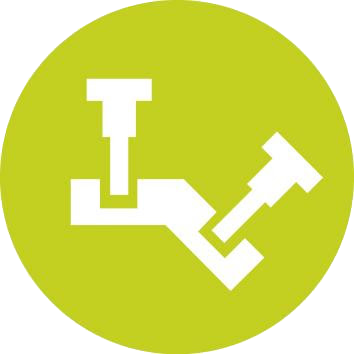(The Multi- Axis State of Mind)
Part 1: Introduction
Multi-axis CNC equipment can provide significant advantages over 3-axis systems. However, to take full advantage of multi-axis you need to learn to think differently about how you set up and implement your manufacturing processes.
 **Part 1: WHY MULTI-AXIS?**
Many manufacturers worldwide feel threatened and defensive when the subject of multi-axis is raised. They conjure up thoughts of complicated and expensive equipment with multiple spindles and axes that are way beyond their talent and financial resources to acquire and master. This is rarely the case.
**Part 1: WHY MULTI-AXIS?**
Many manufacturers worldwide feel threatened and defensive when the subject of multi-axis is raised. They conjure up thoughts of complicated and expensive equipment with multiple spindles and axes that are way beyond their talent and financial resources to acquire and master. This is rarely the case.
Rather than getting terrified over some fuzzy notion of how multi-axis could go wrong, a better approach to wrapping your mind around the concept is to get a better understanding of the advantages. They are clear-cut and easy to understand:
- Eliminate Setups: Every time you flip a part to machine it from a different angle you are consuming the valuable time of a skilled machinist while the machine stands idle. This results in a substantial loss of both equipment and manpower productivity. This problem is compounded when there are a large number of identical parts but can also be a factor for short runs. Stripping out set-up time, even for relatively simple parts, can result in productivity improvements of 25% to 50%…and even better for geometrically complex, precision parts.
- Improve Accuracy: Every additional flip (set-up change) introduces additional stacking errors, which can result in scrap or inconsistent manufacturing results.
- Use Manpower More Effectively: Skilled 3-axis programmers with some good guidance and training can program and operate several multi-axis systems because they don't have to spend as much time doing meticulous setups. The additional time gained can also be used to train promising candidates to back them up.
- Open Doors for New Growth Opportunities: The ability to make difficult parts with high precision, competitive pricing and reasonable deliveries is likely to open some eyes among current and potential customers.
In short, an increasing number of users are finding out that multi-axis equipment is an important if not essential aspect of their business. While transitioning to multi-axis manufacturing is becoming increasingly important, it does not have to be overwhelmingly complex. The goal is to keep the transition process as simple as possible.